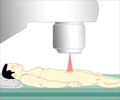HDR (high dose rate) brachytherapy in combination with an innovative new image-guidance technology was shown to be just as effective as conventional therapies.
Up to 79% preservation of potency and less than 2% incontinence are the striking results of a clinical study in which over 300 men received an innovative treatment for prostate cancer. HDR (high dose rate) brachytherapy in combination with an innovative new image-guidance technology was shown to be just as effective as conventional therapies, but much less likely to cause the common side-effects of impotence and incontinence.
Conventional Therapy vs, HDR Brachytherapy and the New Image-Guidance TechnologyStandard treatments for prostate cancer are surgery (prostatectomy) to remove the prostate, and radiotherapy. Normally, radiotherapy is delivered from an external source situated at a distance (a process known as teletherapy or external beam therapy), and is therefore directed over the entire prostate area. This makes it virtually impossible to avoid penetrating healthy tissue, including the sensitive urethra running through the middle of the prostate, and the neurovascular bundles (on either side at the base of the prostate) that control penile function. After surgery or conventional teletherapy, between 40-100% of men will be left impotent, and 35% of surgery patients will suffer incontinence.
In brachytherapy, on the other hand, the tumour is irradiated from the inside. In prostate cancer therapy, this is achieved by introducing small tubes into the prostate at specific points, and then inserting a radioactive isotope either temporarily (HDR) or permanently (tiny implants) into each tube to deliver the appropriate dose.
Until recently, the precision of HDR brachytherapy was determined by positioning of the tubes based on CT imaging. However, CT scans tend to produce indistinct images of the prostate. Furthermore, the images have to be taken after rather than during the tube insertion, and so can prove inaccurate as the position of the prostate and other internal organs adjacent to it may move.
A new technology to further improve the precision of HDR brachytherapy was therefore developed by a multidisciplinary team of Radiation Oncologists and Medical Physicists together with Nucletron, a leading manufacturer of radiotherapy equipment and software. The real-time image-guidance technology that they created has now made it possible to view crucial aspects of the procedure in real time, rather than relying on past images. This means that clinicians can view the position of the organs, check whether the tubes are following the right insertion pathways, and amend the dose to more accurately target the tumour while avoiding vulnerable areas.
Results Just Published
The outcome of the study featuring this new technology, comprising over 300 patients, was announced last week at the 12th International Conference on Optimal use of Advanced Radiotherapy on Multimodality Oncology in Rome. The study itself was performed by Professors Zamboglou, Tunn and Baltas from the University Hospital in Offenbach, Germany. By uniting a multidisciplinary team of urologists, radiation oncologists and clinical physicists working closely together, they were able (and continue) to achieve excellent results with minimum side-effects.
With a radiation source inside rather than outside the body, there is no need to penetrate healthy tissue in order to reach the target. As Professor Nikolaos Zamboglou from Offenbach comments, "Conventional prostate cancer radiotherapy involves treating the tumour from the outside in. But you get far fewer side-effects if you treat it from the inside out. And with this new imaging technology, we can really hit the spot."
Monitoring and Adaptability Important
It was shown that HDR brachytherapy in combination with the live image-guidance technology makes it easy to monitor both the tumour and adjacent organs during treatment. Nucletron's innovative technology enables a combination of on-line tracking, guidance and possible adaptive interventions to be used. The team is able to make intermediate adaptations when required, for example by re-imaging the patient and adjusting the dose before each treatment session, "Often, it is this interventional option that can make the difference", Professor Zamboglou confirms.
Prostate Cancer and Quality of Life
Worldwide, 1 in every 6 men will be diagnosed with prostate cancer in the course of their lifetime. About 350,000 new cases are diagnosed each year, of which approximately 75% are of localised prostate cancer. This is the type for which HDR brachytherapy is most suitable, as the tumour has not yet spread beyond the prostate itself.
Modern treatment of prostate cancer using radiotherapy has already produced encouraging results when it comes to fighting the tumour and its possible recurrence. Yet with the rise in average age and also with more and more men wanting to remain active at a higher age, cancer specialists have been facing a tough challenge to further reduce side-effects such as impotence and incontinence. Aiming to meet these rising standards for improving patients' quality of life, they have been seeking new technologies for accurately and effectively targeting the cancer, while preserving long-term organ function.
Reducing the Costs and Impact of Prostate Cancer Treatment
Current estimates stipulate that over 10 billion dollars per year are spent on treating prostate cancer. Facing a rapid rise in the incidence of prostate cancer incidence - not just in the western world but also in developing countries - clinicians and the medical industry feel a responsibility to provide more cost-effective treatment methods.
HDR brachytherapy in combination with the new image-guidance technology has the potential to fulfil this demand. With this therapy, patients spend a maximum of two nights in hospital, with a fortnight's break before the second treatment session involving another two-night stay. This is in contrast to surgery, which usually involves at least a week's recovery time in hospital, and normal teletherapy, which usually involves six to seven weeks of daily treatment in hospital. An additional benefit is that the equipment required for the new technology is much less expensive than that used in conventional treatment methods.
The Prostrate Cancer Treatment of the Future?
According to Professor Zamboglou, the advanced new image-guidance technology "stands out through its ease of use and its wide applicability."
With the appropriate infrastructure in place, HDR brachytherapy in combination with the new image-guidance technology has the potential to offer treatment that is more affordable, more convenient for patients and more able to preserve their quality of life.
Source: PRNewswire
SRM/M




![Prostate Specific Antigen [PSA] Prostate Specific Antigen [PSA]](https://www.medindia.net/images/common/patientinfo/120_100/prostate-specific-antigen.jpg)






